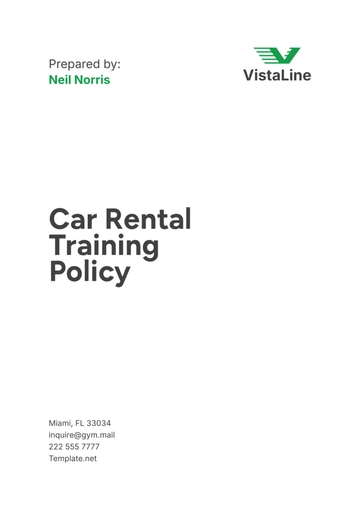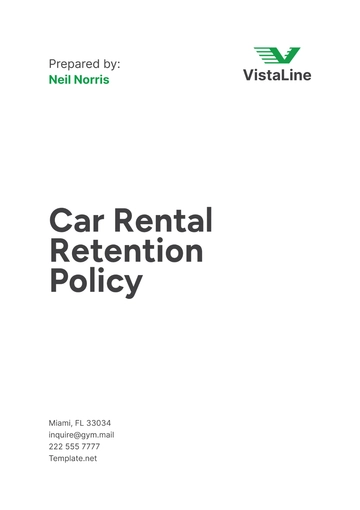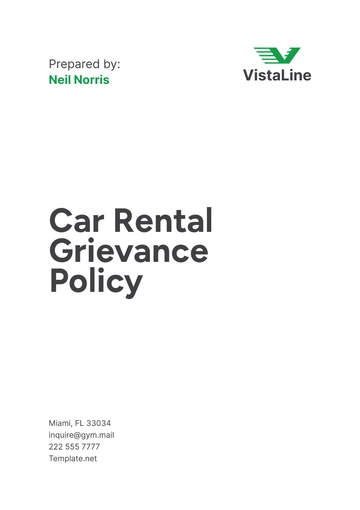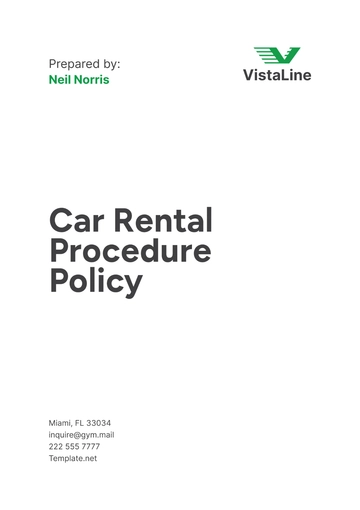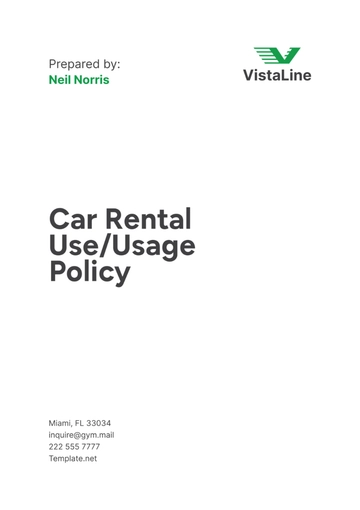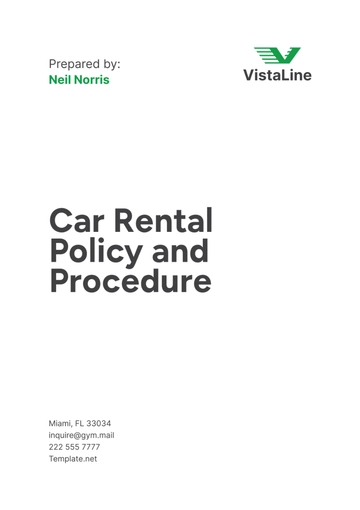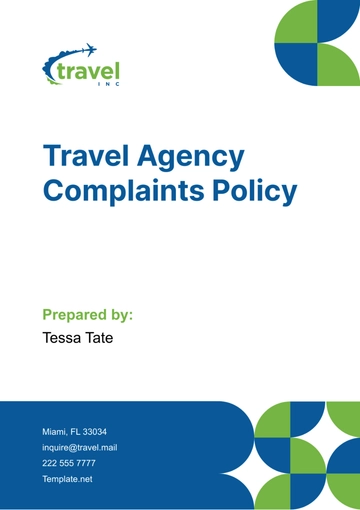Free Car Rental Grievance Policy
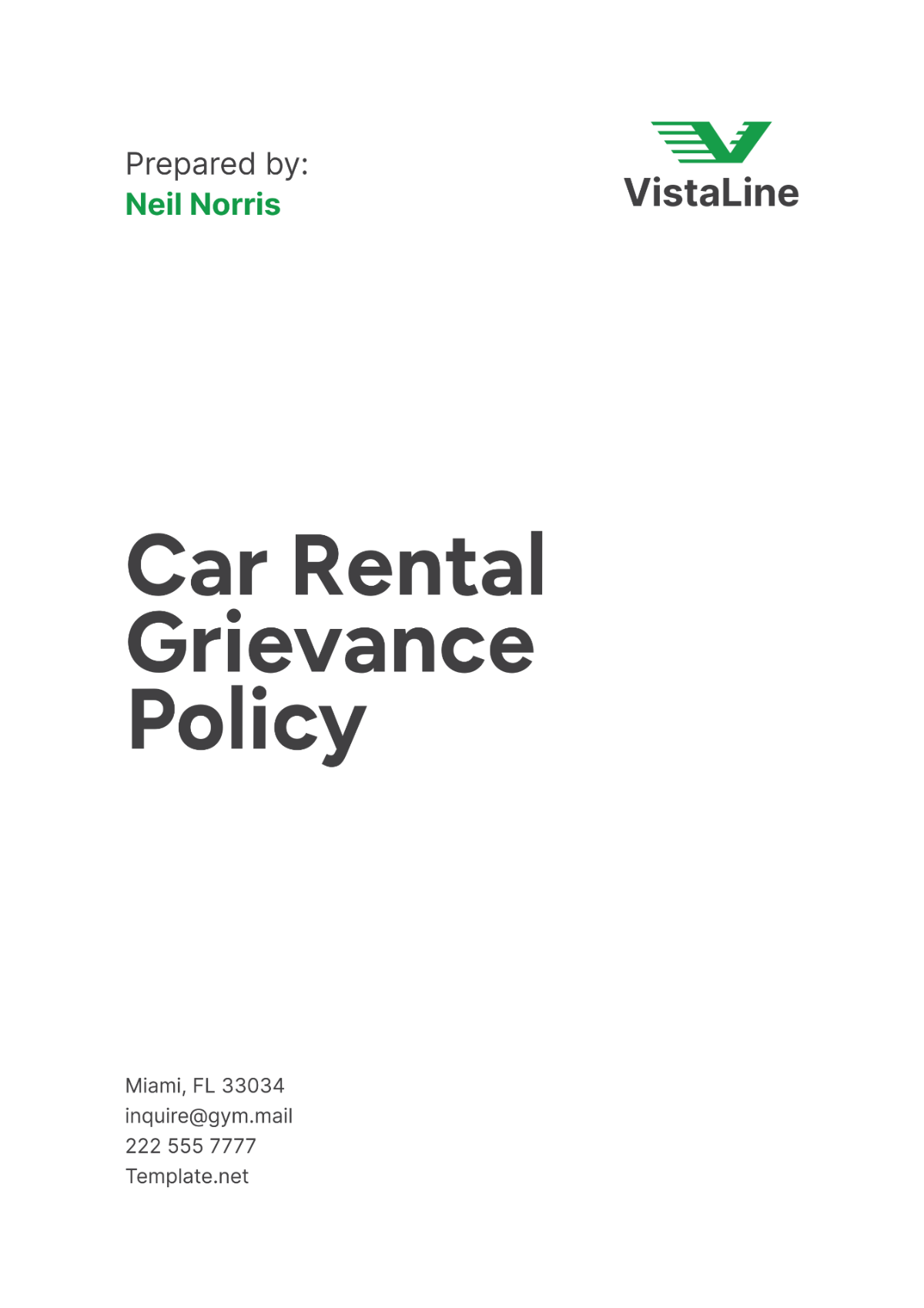
I. Introduction
A. Purpose
The purpose of this Grievance Policy is to provide a structured and transparent procedure for addressing and resolving grievances raised by employees of [Your Company Name]. Ensuring that grievances are handled fairly and promptly is critical for maintaining a positive work environment and fostering employee satisfaction.
B. Scope
This policy applies to all employees of [Your Company Name], including full-time, part-time, temporary, and contract staff. It covers all types of grievances, including those related to working conditions, management practices, and interpersonal conflicts.
C. Responsibilities
Management: Ensure the grievance procedure is implemented and followed. Provide necessary support and resources for resolving grievances.
Employees: Understand and adhere to the grievance procedure. Report grievances promptly and participate in the resolution process.
Human Resources: Facilitate the grievance process. Maintain confidentiality and documentation of all grievance cases.
II. Grievance Submission
A. Reporting a Grievance
Employees should follow these steps to report a grievance:
Initial Report: Report the grievance to your immediate supervisor verbally or in writing. Provide a clear and detailed description of the issue.
Documentation: Submit any relevant documents or evidence supporting the grievance. This helps in understanding the context and assessing the grievance accurately.
Confidentiality: Request confidentiality if desired. The company will respect this request to the extent possible while addressing the grievance.
Follow-Up: Follow up with your supervisor if there is no response within a reasonable timeframe. Ensure that the grievance is being addressed.
Escalation: If the grievance is not resolved satisfactorily, escalate it to higher management or the Human Resources department.
B. Grievance Form
The following table outlines the components of the Grievance Form:
Component | Description |
|---|---|
Employee Information | Includes employee name, position, and contact details. |
Grievance Details | Detailed description of the grievance, including date and location. |
Supporting Evidence | List and attach any documents or evidence related to the grievance. |
Desired Outcome | Employee's suggested resolution or outcome for the grievance. |
Management Comments | Section for management's response and action taken. |
Employee Information: This section includes the name, position, and contact details of the employee filing the grievance. Accurate information is necessary for effective communication and follow-up.
Grievance Details: A detailed description of the grievance helps in understanding the nature and context of the issue. It should include specifics such as the date, time, and location of the incident.
Supporting Evidence: Any documents, emails, or other evidence related to the grievance should be listed and attached. This evidence supports the grievance and helps in the investigation.
Desired Outcome: The employee should indicate their desired resolution or outcome. This helps management understand the employee's expectations and work towards a satisfactory resolution.
Management Comments: Management uses this section to document their response to the grievance and the actions taken. It ensures transparency and accountability in the grievance resolution process.
III. Grievance Investigation
A. Initial Assessment
Upon receiving a grievance, the initial assessment steps should be followed:
Acknowledge Receipt: Acknowledge the receipt of the grievance to the employee within 48 hours. This reassures the employee that their grievance is being taken seriously.
Assign Investigator: Assign an impartial investigator to the case. The investigator should have no conflict of interest with the parties involved.
Review Evidence: Review the grievance details and any supporting evidence. This helps in understanding the scope and context of the issue.
Interview Parties: Schedule interviews with the employee, any witnesses, and the subject of the grievance. Collect additional information and perspectives.
Preliminary Findings: Prepare a preliminary report with initial findings and recommendations. Share this report with the management for further action.
B. Investigation Process
The following table provides an overview of the investigation process:
No. | Step | Description |
|---|---|---|
1 | Data Collection | Gather all relevant information, including documents and interview notes. |
2 | Analysis | Analyze the collected data to identify key issues and patterns. |
3 | Findings | Document the findings of the investigation in a comprehensive report. |
4 | Recommendation | Provide recommendations for resolving the grievance and preventing recurrence. |
Data Collection: Gathering all relevant information, including documents, emails, and interview notes, is essential for a thorough investigation. This step ensures that no critical detail is overlooked.
Analysis: Analyzing the collected data helps in identifying key issues, patterns, and root causes of the grievance. It provides a solid foundation for making informed decisions.
Findings: Documenting the findings in a comprehensive report ensures transparency and accountability. It serves as a record of the investigation and supports the decision-making process.
Recommendation: Providing recommendations for resolving the grievance and preventing recurrence is crucial for maintaining a positive work environment. It demonstrates a commitment to addressing issues and improving workplace practices.
IV. Grievance Resolution
A. Resolution Steps
Once the investigation is complete, the following steps should be taken to resolve the grievance:
Review Findings: Management reviews the findings of the investigation. Ensure that all aspects of the grievance have been thoroughly examined.
Determine Action: Decide on the appropriate action to address the grievance. This may include disciplinary action, policy changes, or other corrective measures.
Communicate Decision: Communicate the decision and actions taken to the employee. Ensure that the communication is clear, respectful, and supportive.
Implement Actions: Implement the decided actions promptly. Monitor the situation to ensure that the actions are effective and the issue does not recur.
Follow-Up: Conduct follow-up meetings with the employee to ensure their satisfaction with the resolution. Address any additional concerns they may have.
B. Documentation and Record Keeping
The following table outlines the key components of documentation and record-keeping for grievances:
Component | Description |
|---|---|
Grievance Log | Maintain a log of all grievances received, including dates and outcomes. |
Investigation Reports | Keep detailed reports of all grievance investigations. |
Action Records | Document all actions taken in response to grievances. |
Follow-Up Notes | Record follow-up communications and meetings with the employee. |
Grievance Log: Maintaining a log of all grievances received helps in tracking and managing grievances efficiently. It provides an overview of the types and frequency of grievances, aiding in identifying patterns and areas for improvement.
Investigation Reports: Keeping detailed reports of all investigations ensures transparency and accountability. These reports serve as a record of the investigation process and support decision-making.
Action Records: Documenting all actions taken in response to grievances is crucial for ensuring that the resolution process is thorough and effective. It helps in tracking the implementation of corrective measures and their impact.
Follow-Up Notes: Recording follow-up communications and meetings with the employee ensures that their concerns are addressed comprehensively. It demonstrates a commitment to ongoing support and resolution.
V. Appeals Process
A. Right to Appeal
Employees have the right to appeal if they are not satisfied with the resolution of their grievance. The following steps outline the appeals process:
Submit Appeal: Submit a written appeal to the Human Resources department within 10 days of receiving the grievance resolution. Clearly state the reasons for the appeal.
Review Appeal: Human Resources will review the appeal and the original investigation report. They will assess whether the grievance was handled fairly and thoroughly.
Assign Appeal Investigator: Assign a different, impartial investigator to handle the appeal. The investigator should have no prior involvement in the case.
Conduct Appeal Investigation: The appeal investigator will conduct a thorough review of the case, including re-interviewing parties if necessary. They will prepare a report with their findings.
Final Decision: The Human Resources department will review the appeal report and make a final decision. Communicate this decision to the employee in writing.
B. Appeal Form
The following table outlines the components of the Appeal Form:
Component | Description |
|---|---|
Employee Information | Includes employee name, position, and contact details. |
Appeal Details | Detailed description of the reasons for the appeal. |
Supporting Evidence | List and attach any additional documents or evidence. |
Desired Outcome | Employee's suggested resolution or outcome for the appeal. |
Management Comments | Section for management's response to the appeal. |
Employee Information: This section includes the name, position, and contact details of the employee filing the appeal. Accurate information is necessary for effective communication and follow-up.
Appeal Details: A detailed description of the reasons for the appeal helps in understanding the employee’s concerns and assessing whether the original grievance was handled properly.
Supporting Evidence: Any additional documents, emails, or other evidence related to the appeal should be listed and attached. This evidence supports the appeal and helps in the investigation.
Desired Outcome: The employee should indicate their desired resolution or outcome for the appeal. This helps management understand the employee’s expectations and work towards a satisfactory resolution.
Management Comments: Management uses this section to document their response to the appeal and the actions taken. It ensures transparency and accountability in the appeal resolution process.
VI. Confidentiality
A. Importance of Confidentiality
Confidentiality is critical in the grievance process to protect the privacy of all parties involved. It helps in maintaining trust and encouraging employees to report grievances without fear of retaliation.
B. Confidentiality Measures
Secure Documentation: Store all grievance-related documents in a secure, restricted-access location. Ensure that only authorized personnel have access.
Anonymity: Provide options for employees to report grievances anonymously if they prefer. Anonymity can help in situations where employees fear retaliation.
Non-Disclosure: Ensure that all parties involved in the grievance process sign non-disclosure agreements. This prevents unauthorized sharing of sensitive information.
Confidential Communication: Use secure communication channels for discussing grievance details. Avoid sharing information through unsecured or public means.
Data Protection: Implement data protection measures to safeguard electronic records. Regularly review and update security protocols to address emerging threats.
C. Breach of Confidentiality
The following table outlines the consequences of breaching confidentiality:
Breach Type | Description | Consequences |
|---|---|---|
Unauthorized Access | Accessing grievance documents without permission. | Disciplinary action, including termination. |
Information Leakage | Sharing grievance details with unauthorized individuals. | Formal warning, suspension, or termination. |
Data Mishandling | Failing to secure grievance-related data properly. | Mandatory retraining, disciplinary action. |
Unauthorized Access: Accessing grievance documents without permission is a serious breach of confidentiality. It undermines the trust in the grievance process and may result in disciplinary action, including termination.
Information Leakage: Sharing grievance details with unauthorized individuals is a violation of confidentiality agreements. It can lead to formal warnings, suspension, or termination, depending on the severity of the breach.
Data Mishandling: Failing to secure grievance-related data properly is a critical issue. It compromises the privacy of the parties involved and may result in mandatory retraining and disciplinary action.
VII. Training and Awareness
A. Training Programs
Training programs should be implemented to ensure all employees are aware of the grievance policy and procedures. The following steps outline the training process:
Develop Training Materials: Create comprehensive training materials that cover all aspects of the grievance policy. Ensure that the materials are accessible and easy to understand.
Conduct Training Sessions: Schedule regular training sessions for all employees. These sessions should include presentations, discussions, and Q&A segments.
Role-Playing Exercises: Incorporate role-playing exercises into the training. These exercises help employees understand how to report grievances and participate in the resolution process.
Feedback Mechanism: Implement a feedback mechanism to gather employee feedback on the training sessions. Use this feedback to improve the training materials and sessions.
Ongoing Education: Provide ongoing education and updates on the grievance policy. Ensure that employees are aware of any changes or updates to the policy.
B. Awareness Campaigns
The following table outlines the components of awareness campaigns:
Campaign Component | Description |
|---|---|
Posters and Flyers | Distribute posters and flyers that outline the grievance process. |
Digital Communication | Use email and intranet to share information about the grievance policy. |
Workshops | Conduct workshops to discuss the grievance policy and procedures. |
Informational Videos | Create and share videos that explain the grievance process. |
Posters and Flyers: Distributing posters and flyers that outline the grievance process helps in raising awareness among employees. These materials should be placed in common areas where they are easily visible.
Digital Communication: Using email and the company intranet to share information about the grievance policy ensures that all employees have access to the information. Regular updates and reminders can help in keeping the policy top of mind.
Workshops: Conducting workshops to discuss the grievance policy and procedures provides employees with an opportunity to ask questions and gain a deeper understanding. These workshops should be interactive and informative.
Informational Videos: Creating and sharing videos that explain the grievance process can be an effective way to engage employees. Videos can be more engaging and easier to understand than written materials.
VIII. Monitoring and Evaluation
A. Monitoring Grievances
Regular monitoring of grievances is essential for identifying trends and areas for improvement. The following steps outline the monitoring process:
Grievance Tracking: Use a grievance tracking system to monitor all grievances received. Ensure that the system is updated regularly.
Trend Analysis: Conduct regular trend analysis to identify common issues and areas for improvement. Use this analysis to inform policy changes and training programs.
Employee Feedback: Gather feedback from employees on the grievance process. Use this feedback to improve the process and address any concerns.
Management Reviews: Conduct regular reviews of the grievance process with management. Discuss any issues or areas for improvement and develop action plans.
Continuous Improvement: Implement continuous improvement measures to enhance the grievance process. Regularly review and update the policy and procedures.
B. Evaluation Metrics
The following table outlines the key evaluation metrics for the grievance process:
Metric | Description |
|---|---|
Grievance Resolution Time | Average time taken to resolve grievances. |
Employee Satisfaction | Employee satisfaction with the grievance process. |
Number of Grievances | Total number of grievances received. |
Recurrent Issues | Frequency of recurring issues. |
Policy Compliance | Compliance with the grievance policy and procedures. |
Grievance Resolution Time: Monitoring the average time taken to resolve grievances helps in identifying bottlenecks and areas for improvement. Reducing resolution time can improve employee satisfaction and trust in the process.
Employee Satisfaction: Gathering feedback on employee satisfaction with the grievance process is crucial for understanding their experiences and identifying areas for improvement. High satisfaction levels indicate a fair and effective process.
Number of Grievances: Tracking the total number of grievances received provides insights into the prevalence of issues within the company. Analyzing this data can help in identifying trends and areas for improvement.
Recurrent Issues: Monitoring the frequency of recurring issues helps in identifying persistent problems that need to be addressed. Addressing these issues can improve the overall work environment.
Policy Compliance: Ensuring compliance with the grievance policy and procedures is essential for maintaining a fair and transparent process. Regular audits and reviews can help in identifying and addressing compliance issues.
IX. Review and Update
A. Review Frequency
Schedule Reviews: We will schedule bi-annual reviews of the grievance policy. We will ensure that these reviews are conducted by the Human Resources department and involve relevant stakeholders.
Gather Feedback: Feedback will be collected from employees and management on the grievance policy. Use this feedback to identify areas for improvement.
Assess Policy Effectiveness: We will assess the effectiveness of the current policy and procedures. Identify any gaps or areas that need to be updated.
Update Policy: Make necessary updates to the grievance policy based on the review findings. Ensure that all updates are communicated to employees.
Implement Changes: Implement the updated policy and procedures. Provide training and support to employees to ensure a smooth transition.
B. Review Components
Policy Effectiveness: Assessing the overall effectiveness of the grievance policy helps in identifying areas that need improvement. This assessment should consider the resolution time, employee satisfaction, and the number of grievances received.
Compliance: Reviewing compliance with the policy and procedures ensures that the grievance process is being followed consistently and fairly. This review should include audits and checks to identify any compliance issues.
Employee Feedback: Collecting and analyzing employee feedback provides valuable insights into their experiences with the grievance process. This feedback can highlight areas for improvement and help in making the process more employee friendly.
Best Practices: Identifying best practices and industry standards helps in benchmarking the grievance process against other organizations. Adopting best practices can enhance the effectiveness and fairness of the process.
Update Implementation: Implementing updates and changes to the policy ensures that it remains relevant and effective. This process should include training and support for employees to ensure a smooth transition.
Regular reviews and updates of the grievance policy are essential for maintaining a fair, transparent, and effective process, ensuring that it meets the needs of both employees and the organization.
- 100% Customizable, free editor
- Access 1 Million+ Templates, photo’s & graphics
- Download or share as a template
- Click and replace photos, graphics, text, backgrounds
- Resize, crop, AI write & more
- Access advanced editor
Handle employee grievances professionally with our Car Rental Grievance Policy Template on Template.net! This template includes all necessary procedures for addressing grievances. The customizable format and the AI Editor Tool ensures an efficient and comprehensive policy creation. Editable sections enable you to tailor the policy to your company’s specific requirements!
You may also like
- HR Policy
- Restaurant Policy
- Company Policy
- Accounting Policies and Procedures
- Website Policy
- Privacy Policy
- Safety Policy
- School Policy
- IT and Software Policy
- Law Firm Policy
- Construction Policy
- Interior Design Policy
- Travel Agency Policy
- Education Academic Policy
- Security Policy
- Real Estate Policy
- Expense Policy
- Software Policy






